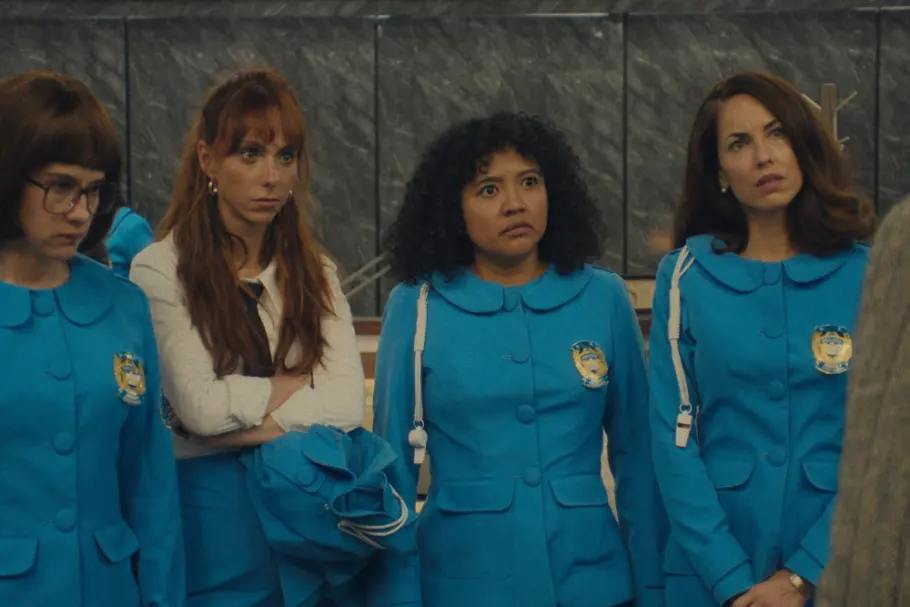WOMEN IN BLUE on AppleTV+ takes viewers into the exciting and dangerous world of Mexico City in the 1970s, following four brave women who break barriers by becoming police officers. The show shows the sexism and cultural limitations these women have to deal with. It also follows the thrilling pursuit of the Undresser, a serial killer. The show tells a complex story that balances intense crime drama with deep social commentary.
The show goes into great detail about these women’s personal and professional lives, showing how hard it is for them to deal with sexism that is deeply ingrained. The main theme is how men treat women in their personal and professional lives. Episodes like “Rosa” give a disturbing look into the killer’s past, and “Alma” and “Ángeles” show how he has gotten away with murder by using misogyny as a weapon. But the big question on everyone’s mind is: Is it based on a true story?
IS WOMEN IN BLUE A TRUE STORY?
WOMEN IN BLUE on Apple TV+ is based on a true event in history: when Mexico hired its first female police officers which was set up in the early 1970s. Fernando Rovzar got the idea for “WOMEN IN BLUE” from Pablo Aramendi, a friend and co-writer who told him about the first police force made up of women. Fernando was interested in the story at first, but after talking to one of the women from the first class, he became really passionate about it. They were treated badly, wore short skirts and knee-high boots, and weren’t allowed to arrest anyone or look into anything. They were told to smile and point tourists in the right direction.
It made Fernando very angry to learn that the government used these women as a distraction from more important problems, like the serial killer in the story and the real-life Mexico City student massacre in 1968. The women stayed and fought for change in the police force even though they were mistreated.
It made Fernando very angry to learn that the government used these women as a distraction from more important problems, like the serial killer in the story and the real-life Mexico City student massacre in 1968. The women stayed and fought for change in the police force even though they were mistreated.
These women chose to stay and fight for change from within the system, even though they had been betrayed. Their strength and determination were what made “WOMEN IN BLUE” what it is. Fernando stressed how important it was to tell this story, not just as history but also as a reminder of how strong and determined these women were. He hopes that the show will make people more aware of systemic injustices and more appreciative of the important roles women play in law enforcement that are often overlooked.
Fernando Rovzar and Pablo Aramendi, the creators, have carefully combined historical accuracy with dramatic storytelling to show the struggles and successes of these women who were ahead of their time. The backdrop of the turbulent 1970s, a time of major social and political change, gives the story a more real feel by reflecting the real struggles women faced during that time.
Making a TV show out of a story that was so sensitive and complicated was not easy. For Fernando, the challenge was to show sensitive topics in a way that was both honest and interesting. He thinks that tough topics shouldn’t be avoided, but should be brought up to start honest conversations.
Fernando said that different parts of the story made him proud of and ashamed of his country. His 18-year-old daughter, for example, saw Mexico’s first female president being elected, which was a big deal. This moment represented the progress that had been made, and Fernando saw a clear link between the struggles of the first female police officers and the progress that has been made in gender equality since then.
According to Fernando, one reason he made “WOMEN IN BLUE” was to honor these unsung heroes. Even though they made important contributions, these women are still not well known in Mexican history. There are no statues or public honors to remember what they did. Fernando hopes that the series will not only be fun to watch, but also shed light on what they did and what they gave up, which will lead to a bigger conversation about their legacy.
Rovzar and Aramendi wanted to show how determined and brave the women were who dared to join the police force, even though society and institutions were against them. Rovzar says, “We wanted to honor these women who broke down barriers and made it possible for others to follow.” They had a strong and brave story, and we thought it was important to show that on the big screen.
Rovzar ties their struggles to today’s world to show how society is still changing. The fact that his daughter helped elect Mexico’s first female president shows how far things have come since those early efforts by women.
Aramendi also says, “We made some changes to the story for dramatic effect, but the core of it is still based on the real lives of these amazing women.” We hope that people who watch will be moved by their story and understand that the fight for gender equality is still going on.
“WOMEN IN BLUE” is a tribute to these women who paved the way. It shows appreciation for what they did and reminds us how important it is to keep fighting for equality.
For more updates on WOMEN IN BLUE and other TV shows, visit tvacute.com frequently for the latest news, previews, and recaps.
APPLE TV+ WOMEN IN BLUE: IS “THE UNDERDRESSER” A REAL SERIAL KILLER?
